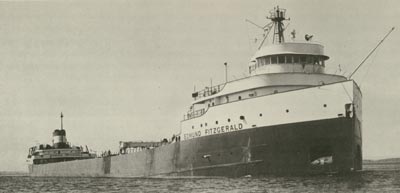Table of Contents
The month of November has, over the years, come to be known as the month that lake sailors and vessel operators dread. For November usually brings with it the nastiest weather that can hit the lakes with poor visibility and vicious winds that can whip the lake waters into a deadly trap for ships unfortunate enough to be caught in exposed areas.
The worst of the November weather seems to come in the middle of the month and for some reason there has been a tragically coincidental association of that sort of weather with November 11th, Remembrance or Armistice Day. On November 11, 1901 the schooner barge MARINE CITY foundered on Lake Huron with the loss of four lives. In the Big Storm of November 9 through 12, 1913 thirteen lake vessels were lost with all hands and many more were driven ashore and severely damaged. On November 12, 1919 the steamer JOHN OWEN disappeared in very heavy weather on Lake Superior and the same storm was the undoing of the wooden lumber carrier H. E. RUNNELLS which stranded near Grand Marais, Michigan, and went to pieces. November 12, 1920 saw the steamer FRANCIS WIDLAR driven ashore on Pancake Shoal, Lake Superior, while the next day the JOHN F. EDDY foundered on Lake Erie. And on November 11, 1940 the steamers ANNA C. MINCH, WILLIAM B. DAVOCK and NOVADOC (II) were lost on Lake Michigan in what is generally called the Armistice Day Storm.

EDMUND FITZGERALD, 1958-1975. Photo by the Editor, July 23, 1974.
And now 1975. Anyone who might have thought that such disasters could not happen in these days of large modern carriers and efficient (supposedly) weather reporting had his hopes dashed when, awakening on the morning of November 11th and turning on his radio, he heard the reports of the tragic events which had taken place on Lake Superior the previous evening.
On November 10th, the steamer EDMUND FITZGERALD, a straight-deck bulk carrier operated by the Columbia Transportation Division, Oglebay Norton and Company, Cleveland, was downbound in Lake Superior with a cargo of about 26,000 tons of taconite pellets bound from Taconite Harbor to Detroit. She was running with the very large seas kicked up by strong winds which accompanied a cold front that was moving eastwards across the lakes bringing a brief indian summer to an abrupt end. The winds, sweeping the full length of the lake, were gusting as high as 80 m.p.h. At about 7:00 p.m., Capt. Ernest McSorley of the FITZGERALD contacted ARTHUR M. ANDERSON which was a short distance away and asked her to stand by in the area as FITZGERALD had suffered some sort of minor damage. PARKER EVANS was also in the vicinity at the time. At 7:10 p.m. when the ship was about thirteen miles off Coppermine Point and almost to the shelter of Whitefish Bay, all visual and radio contact with her was lost. Several vessels remained in the area all through the night to search for survivors or debris but none were found, nor was there any further sighting of the ship herself.
The following day, the wreckage started to come in on the Canadian shore and, from the concentration of debris positively identified as being from EDMUND FITZGERALD, there could be no doubt that the vessel was lost. A few days later the U.S. Coast Guard using depth sounding equipment located a large wreck in the area and it is believed that this is the FITZGERALD, although positive identification of the sunken vessel has not yet been possible as the hull is lying in well over 500 feet of water. Not one of her 29 crewmen has yet come ashore.
EDMUND FITZGERALD was owned by the Northwestern Mutual Life Insurance Company of Milwaukee, Wisconsin, and had been built in 1958 as Hull 301 of the Great Lakes Engineering Works, Ecorse, Michigan. She measured 711.2 x 75.1 x 33.4 with an overall length of 729.3 and tonnage of 13,632 Gross, 8,686 Net. She was powered by a Westinghouse two-cylinder steam turbine with steam supplied by two coal-fired watertube boilers. She had the distinction of being the first maximum Seaway size carrier built on the lakes and now has earned the unenviable record of being the first such vessel to be lost in Great Lakes waters. (The Halco bulker LEECLIFFE HALL (II), also a maximum-sized carrier, was lost by collision September 5, 1964 but this accident took place on the St. Lawrence River below Quebec City.)
To comment on the possible causes of the loss of EDMUND FITZGERALD would not be appropriate at this time. We join the rest of the lake shipping community in expressing our shock and grief at the disappearance of such a fine vessel, and to her owners and operators and to the families of her crew go our deepest sympathy.
Previous Next
Return to Home Port or Toronto Marine Historical Society's Scanner
Reproduced for the Web with the permission of the Toronto Marine Historical Society.